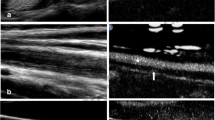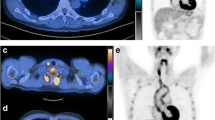Abstract
The aim of this study is to determine the value of whole-body contrast-enhanced magnetic resonance angiography(CE-MRI) with vessel wall imaging in quantitative assessments of Takayasu’s arteritis (TA) disease activity and follow-up examinations. Whole-body CE-MRI with vessel wall imaging (dark blood sequences) was performed in 52 TA patients and repeated in 15 patients after 6 months. Images were analyzed using quantitative scores. The distribution of Lupi-Herrera types (type III, 48.1 %; I, 40.4 %; II, 9.6 %; IV, 1.9 %) did not differ between active and inactive TA. Active vessel inflammation was found in seven patients diagnosed with inactive disease as Kerr scores and mainly involved the aortic arch, abdominal aorta, and ascending aorta. Quantitative MR scores were significantly higher in active TA (luminal stenosis 16.7 ± 5.3 vs. 4.2 ± 3.7, p < 0.01; wall thickening 7.2 ± 3.4 vs. 2.9 ± 2.3, p = 0.02; wall enhancement 8.7 ± 4.1 vs. 3.6 ± 2.4, p = 0.04) and positively correlated with Kerr scores, ITAS 2010, erythrocyte-sedimentation rate (ESR), and C-reactive protein (CRP) and pentraxin-3 (PTX-3) levels. At 6 months, the clinical symptoms, CRP level, and ESR improved significantly (p < 0.05) and wall enhancement decreased (6.7 ± 3.1 vs. 4.1 ± 2.1; p = 0.04), but the luminal stenosis (10.2 ± 4.3 vs. 8.8 ± 5.2; p = 0.12) and wall thickening (6.3 ± 3.8 vs. 5.8 ± 4.2; p = 0.27) remained unchanged. Whole-body CE-MRI with vessel wall imaging detected luminal changes and vessel wall inflammation in TA. Our MR scoring system enabled quantitative assessment of TA activity.



Similar content being viewed by others
References
Johnston SL, Lock RJ, Gompels MM (2002) Takayasu’s arteritis: a review. J Clin Pathol 55:481–486
Matsuura K, Ogino H, Kobayashi J et al (2005) Surgical treatment of aortic regurgitation due to Takayasu arteritis: long-term morbidity and mortality. Circulation 112:3707–3712
Kerr GS, Hallahan CW, Giordano J et al (1994) Takayasu arteritis. Ann Intern Med 120:919–929
Andrews J, Mason JC (2007) Takayasu’s arteritis—recent advances in imaging offer promise. Rheumatology (Oxford) 46:6–15
Chung JW, Kim HC, Choi YH et al (2007) Patterns of aortic involvement in Takayasu’s arteritis and its clinical implications: evaluation with spiral computed tomography angiography. J Vasc Surg 45:906–914
Giodrana P, Baqué-Juston MC, Jeandel PY et al (2011) Contrast-enhanced ultrasound of carotid artery wall in Takayasu’s disease: first evidence of application in diagnosis and monitoring response to treatment. Circulation 124:245–247
Lee KH, Cho A, Choi YJ et al (2012) The role of (18) F-fluorodeoxyglucose-positron emission tomography in the assessment of disease activity in patients with Takayasu’s arteritis. Arthritis Rheum 64:866–875
Wasserman BA, Astor BC, Sharrett AR et al (2010) MRI measurements of carotid plaque in the atherosclerosis risk in communities (ARIC) study: methods, reliability and descriptive statistics. J Magn Reson Imaging 31:406–415
Laible M, Schoenberg SO, Weckbach S et al (2012) Whole-body MRI and MRA for evaluation of the prevalence of atherosclerosis in a cohort of subjectively healthy individuals. Insight Imaging 3:485–493
Filer A, Nicholls D, Corston R et al (2001) Takayasu arteritis and atherosclerosis: illustrating the consequences of endothelial damage. J Rheumatol 28:2752–2753
Ragab Y, Emad Y, El-Marakbi A et al (2007) Clinical utility of magnetic resonance angiography (MRA) in the diagnosis and treatment of Takayasu’s arteritis. Clin Rheumatol 26:1393–1395
Hansen T, Wikstrom J, Eriksson MO et al (2006) Whole-body magnetic resonance angiography of patients using a standard clinical scanner. Eur Radiol 16:147–153
Desai MY, Stone JH, Foo TK et al (2005) Delayed contrast-enhanced MRI of the aortic wall in Takayasu’s arteritis: initial experience. AJR 184:1427–1431
Lin J, Chen B, Wang JH et al (2006) Whole-body three-dimensional contrast-enhanced magnetic resonance (MR) angiography with parallel imaging techniques on a multichannel MR system for the detection of various systemic arterial diseases. Heart Vessels 21:395–398
Jiang L, Li D, Yan F et al (2012) Evaluation of Takayasu arteritis activity by delayed contrast-enhanced magnetic resonance imaging. Int J Cardiol 155:262–267
Arend WP, Michel BA, Bloch DA et al (1990) The American College of Rheumatology 1990 criteria for the classification of Takayasu’s arteritis. Arthritis Rheum 33:1129–1134
Lupi-Herrera E, Sanchez-Torres G, Marcushamer J et al (1977) Takayasu’s arteritis. Clinical study of 107 cases. Am Heart J 93:94–103
Misra R, Danada D, Rajapa SM et al (2013) Development and validation of the Indian Takayasu Clinical Activity Score (ITAS2010). Rheumatology (Oxford) 52:1795–1801
Sider L, Mintzer RA, Vrla RF et al (1985) Use of DSA for diagnosis of Takayasu’s arteritis. IMJ III Med J 167:53–55
Papa M, De Cobelli F, Baldissera E et al (2012) Takayasu’s arteritis: intravascular contrast medium for MR angiography in the evaluation of disease activity. AJR Am J Roentgenol 198:279–284
Schneeweis C, Schnackenburg B, Stuber M et al (2012) Delayed contrast-enhanced MRI of the coronary artery wall in takayasu’s arteritis. PLoS One 7:e50655
Sun Y, Ma L, Jiang L et al (2012) MMP-9 and IL-6 are potential biomarkers for disease activity in Takayasu’s arteritis. Int J Cardiol 156:236–238
Maekawa Y, Nagai T, Anzai A (2011) Pentraxins: CRP and PTX-3 and cardiovascular disease. Inflamm Allergy Drug Targets 10:229–235
Eshet Y, Pauzner R, Goitein O et al (2011) The limited role of MRI in long-term follow-up of patients with Takayasu’s arteritis. Autoimmun Rev 11:132–136
Disclosure
None.
Author information
Authors and Affiliations
Corresponding author
Rights and permissions
About this article
Cite this article
Sun, Y., Ma, L., Ji, Z. et al. Value of whole-body contrast-enhanced magnetic resonance angiography with vessel wall imaging in quantitative assessment of disease activity and follow-up examination in Takayasu’s arteritis. Clin Rheumatol 35, 685–693 (2016). https://doi.org/10.1007/s10067-015-2885-2
Received:
Revised:
Accepted:
Published:
Issue Date:
DOI: https://doi.org/10.1007/s10067-015-2885-2




